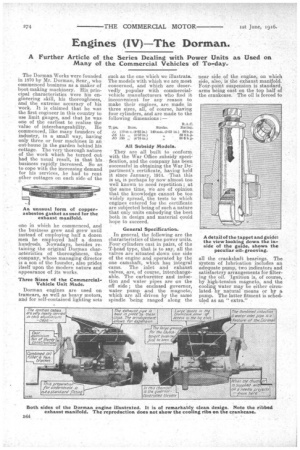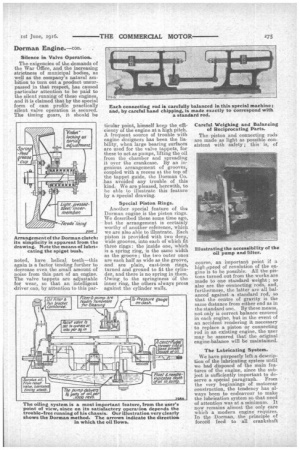Engines (IV) The Dorman.
Page 12

Page 13

Page 14

If you've noticed an error in this article please click here to report it so we can fix it.
A Further Article of the Series Dealing with Power Units as Used on Many of the Commercial Vehicles of To-day..
The Dorman Works were founded in 1870 by Mr. Dorman, Senr., who commenced business as a maker of boot-making machinery. His principal characteristics were his engineering skill, his thoroughness, . and the extreme accuracy of his • work. It is claimed that he was the first engineer in this country to use limit gauges, and that he was one of the earliest to re.alize the
value of interchangeability. Be commenced, like many founders. of industry, in a small way, having only three or four machines in an out-house in the garden behind his cottage. The very 'thorough nature of the work which he turned out had the usual result, in that his business rapidly increased. So as to cope with the increasing demand for •his services, he had to rent other cottages on each side of the
An unusual form of copper. asbestos gasket as used for the exhaust manifold.
• one in which he commenced, and the business grew and grew until instead of employing half a dozen men he employed half a dozen hundreds. Nowadays, besides retaining the original Dorman characteristics of thoroughness, the company, whose managing director is a son of the founder, also prides itself upon the modern nature and appearance of its works.
Three Sizes of the Commercial. Vehicle Unit Made.
Dorman engines are used on tramcars, as well as heavy motors, and for self-contained lighting sets such as the one which we illustrate. The models with which we are most concerned, and which are deservedly popular with commercialvehicle manufacturers who find it inconvenient for any reason to make their engines, are made in three sizes, all, of course, having four cylinders, and are made to the following dimensions :—
R.A.C.
T;.pe. Bore. Stroke.
Je 110 M u. (413 in.) 14.0 mm. (5.50 in ) 80 h.p.
J.K 1k. „ (4•50 in.) . S9 8 h.p.
JO 124 „. (41d in.) I 315.6 h.p.
All Subsidy Models.
They are all built to conform with the War Office subsidy speci-2 fication, and the company has been successful in obtaining the War Department's certificate, having held it since January., 1914. That this is SO., is perhaps by now almost too well known to need repetition ; at the same time, we are of 'opinion that the knowledge cannot be too widely spread, the tests to which engines entered for the certificate are subjected being of such a nature that only units embodying the best both in 'design and material could hope to succeed.
General Specification.
• In general, the following are the characteristics of these power units. Four cylinders cast in pairs, of the T-head type, that is to say, all the valves are situated down one side of the engine and operated by the one camshaft, which has integral cams. The inlet and exhaust valves, are, of course, interchangeable. The carburetter and induction and water pipes are on the off side ; the enclosed governor, water pump and the magneto, which are all driven by the same spindle 'being ranged along the
near side of the engine, on which side, also, is the exhaust manifold. Four-point suspension is standard, arms being cast on the top half of the crankcase. The oil is forced to
all the crankshaft bearings. The System of lubrication includes an adequate pump, two indicators and satisfactory arrangements for filtering the oil. Ignition is, of course, by high-tension magneto, and the cooling water may be either circulated by natural means or by a pump. The latter fitment is scheduled as an " extra."
Silence in Valve Operation.
The exigencies of the demands of the War Office, and the increasing strictness of municipal bodies, as well as the company'snatural ambition to turn out a product unsurpassed in that respect, has caused particular attention to be paid to the silent running of these engines, and it is claimed that by the special form of cam profile practically silent valve operation is secured. The tuning gears, it should be
noted, have helical teeth—this again is a factor tending further to decrease even the small amount of noise from this part of an engine. The valve tappets are adjustable for wear, so that an intelligent driver can; by attention to this paaa
ticular point, himself keep the efficiency of the engine at a high pitch. A frequent source of trouble with engine designers has been the liability, when large bearing surfaces are used for the valve tappets, for these to act as pumps, lifting the oil from the chamber and spreading it over the crankcase. By an ingenious arrangement of grooves, coupled with a recess at the top of the tappet guide, the Dorman Co. has avoided any trouble of this kind. We are pleased, herewith, to be able to illustrate this feature by a special drawing.
Special Piston Rings.
Another special feature of the Dorman engine is the piston rings. We described these some time ago, but the arrangement is certainly worthy of another reference, which we are also able to illustrate. Each piston is provided with two deep, wide grooves, into each of which fit three rings : the inside one, which is a spring ring, is the same width as the groove ; the two 'outer ones are each half as wide as the groove, and are plain, east-iron rings, turned and ground to fit the cylinder, and there is no spring in them. Owing . to the springiness of the inner ring, the others always press against the cylinder walls. Careful Weighing and Balancing of Reciprocating Parts.
The piston and connecting rods are made as light as possible consistent with safety ; this is, of
course, an important point if a higliespeed of revolution of the engine'is to be possible. All the pistons turned out from the works are made to one standard weight ; so also are the connecting rods, and, furthermore, the latter are all balanced against a standard rod, so that the centre of gravity is the same distance from either end as in the standard one. By these means, not only is correct balance ensured in each engine, but in the event of an accident rendering it necessary to replace a piston or connecting rod in an existing engine, the -user may be assured that the original engine-balance will be maintained.
The Lubricating System.
We have purposely left description of the lubricating system until we had disposed of the main features of the engine, since the subject is sufficiently important to deserve a special paragraph. From the very beginnings of motorcar construction, the tendency has always been to endeavour to make the lubrication system so that need of attention was at a minimum. It now remains almost the only care which a modern engine requires. In the Dorman, the principle of forced feed to all crankshaft bearings is adopted. A pump of ample capacity driven by spiral gearing from the crankshaft at engine speed, is fitted in the sump. This delivers oil to a pipe inside the crankcase, from which are led A cross-sectional view of the Dorman engine.
•
three branches, one to each main bearing, and at the end of this pipe is a relief valve, which is set to operate at 10 lb. pressure. The pump has a capacity to deliver, with the engine running at 1000 revolutions per minute, 1i gall, in that time, and is capable, when the oil is cold, that is to say, at starting, of working at a pressure of something like 60 lb. per sq. in. Naturally, since the main bearings and connecting-rod bearings (the latter are served through holes
drilled in the crankshaft), do not together need anything like this quantity of oil,a, very large percent-.
age overflows through the relief valve, where it is allowed to pour on to the timing gears. The cylinder walls, gudgeon pins and camshaft bearings are lubricated by means of oil thrown off from the connecting-rod ends. It is claimed that by. provision of such an excess of lubricant, there is sufficient, in the event of one or other of the bearings becoming considerably worn and therefore liable to allow a fair amount of oil to escape, still to. ensure that all are lubricated. Even with all bearings slack it is more than likely that there would still be oil enough to lubricate the bearings, as well as the timing gears. In common with, almost all other engine makers, the Dorman Engineering Co., Ltd., has found it advisable to provide ample space for oil, and the capacity of the sump in this respect is three gallons ; also, owing to its position
in relation to the oil pump, there should be no fear of the pimp ever running dry. A needle-and-float indicator at the side of the crankcase sertes to indicate the amount of oil in the sump, and a pressure gauge is fitted on the dash to show the pressure available throughout" the system.
Thorough Testing: All Dorman engines are subjected to thorough and searching tests before being allowed to leave the works. As soon as erected, each one is placed on the test bench and run for two hours under a light load, using coal gas. It is then run for a couple of hours at half load with petrol, and next., another two hours at full load, again with petrol ; this time it is expected. to develop during the whole period at least the horse-power as stated in the catalogue, and its consumption of fuel must not exceed .7 Of a pint per -horse-power hour. Throughout these tests, the man in charge is carefully examining it for any faults, which, of course, he must duly report. Each engine is then dismantled completely, and the corrections required by the tester are made ; the unit is afterwards built up again completely and run under full load for another short period, and is then ready for despatch.




















